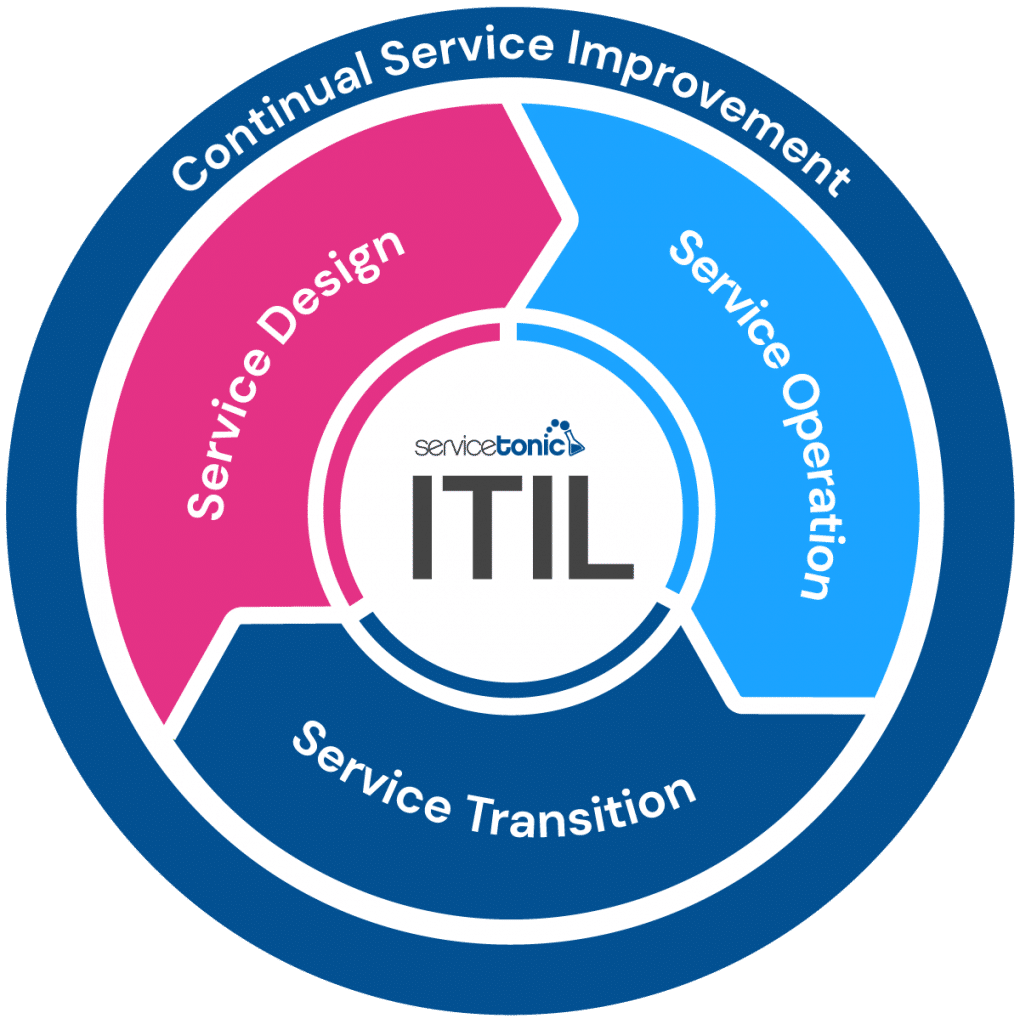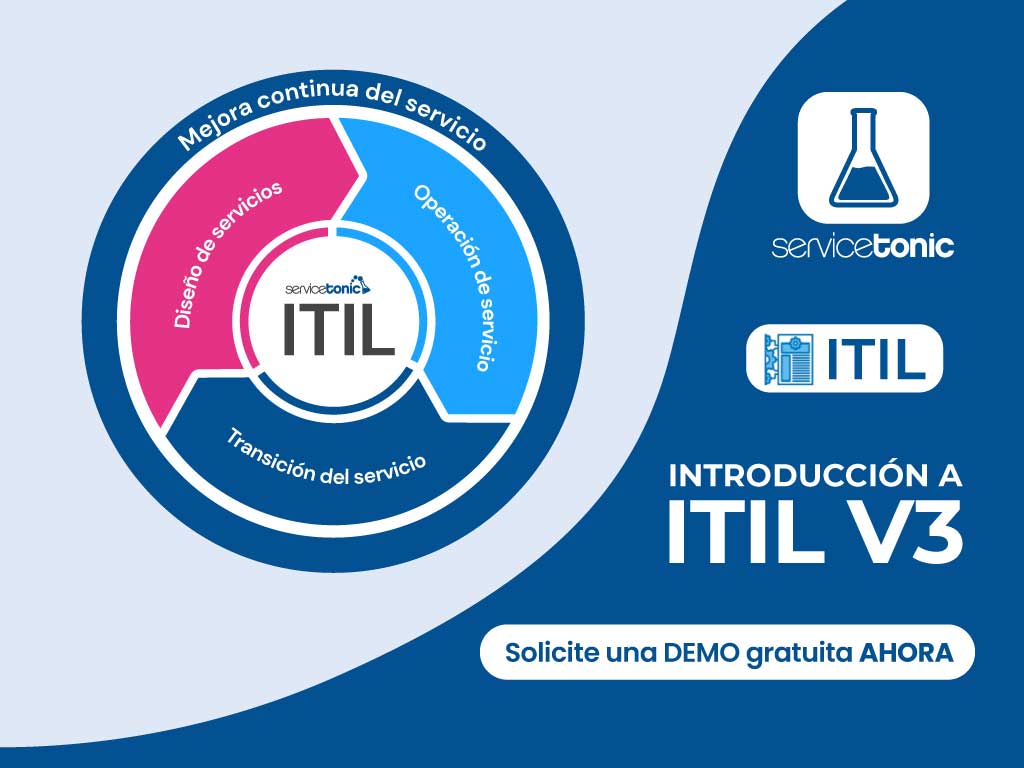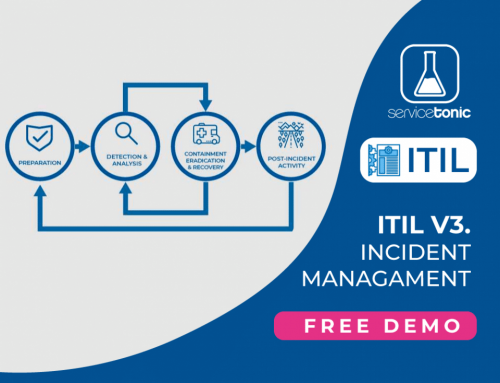Table of Contents
What is ITIL?
ITIL (Information Technology Infrastructure Library) is a set of best practices designed for the efficient management of IT services (ITSM).
ITIL v3, also known as ITIL 3, was published in 2007 and structured the service lifecycle into five key phases: Service Strategy, Design, Transition, Operation, and Continual Service Improvement.
The goal of ITIL v3 is to align technology with business needs, optimize operating costs, and enhance the quality of IT services.
Although the most recent version, ITIL 4 (2019), provides an updated approach, ITIL v3 is still widely used as a practical foundation. In fact, ITIL 4 does not replace v3 but rather expands upon it by incorporating concepts such as value co-creation, Lean, Agile, and DevOps.
This article reviews the fundamental processes of ITIL v3, explaining how they work in each phase of the service lifecycle and how they can be supported with an ITSM tool like ServiceTonic.
To further explore the basic terms and principles of the ITIL framework, you may consult our article “What is ITIL? Concepts and Principles“.
Service Strategy in ITIL v3
The Service Strategy phase considers IT services as strategic assets of the organization. In this stage, the overall direction of service management is defined and decisions are made, such as:
- Identifying and prioritizing business opportunities and services that generate value.
- Creating differentiating features compared to competitors to strengthen market positioning.
- Ensuring the organization can sustain the costs and risks associated with its service catalog.
- Improving the alignment of service management capabilities with business strategies.
- Determining what services should be implemented and why, before asking how to do it.
The processes associated with the service strategy are as follows:
Financial Management
Financial Management in ITIL v3 enables informed decision-making regarding IT services from an economic perspective. This process ensures the viability and sustainability of services through effective cost control, resource management, and value generation.
- It evaluates the economic value of IT services and assets, estimating their worth and forecasting associated provisioning and maintenance costs.
- It regulates service demand using pricing models that influence user consumption patterns.
Service Portfolio Management
Oversees investments in the service lifecycle (strategy, design, transition, operation). It continuously assesses key questions: Is the service viable and marketable? Is it profitable and sustainable? Is it operationally manageable? This process helps decide whether to launch, update, or retire services, ensuring balance between market demand and operating costs.
Demand Management
Forecasts and regulates service demand to optimize resource usage. Its function is to align available capacity with user consumption patterns, using tools like communication campaigns, shift models, or differentiated pricing.

Service Designs in ITIL V3
In the Service Design phase, strategic objectives are translated into concrete services. The goal is to create or modify services and their associated elements (processes, technology, people) in alignment with the Service Strategy. This includes developing new services and updating existing ones to meet business requirements.
Key processes in Service Design:
Service Catalog Management
Ensures that the service catalog is complete and properly documented. It includes all active and in-development services, allowing any authorized user to know the available services and their basic attributes.
Service Level Management (SLA)
Negotiates, agrees on, documents, and maintains service quality objectives. It monitors and reports on the service level agreements (SLAs) achieved during service delivery.
Capacity Management
Ensures that IT infrastructure has the necessary resources to support service demand at the agreed quality levels.
Availability Management
Monitors and optimizes services to deliver the agreed level of availability at the lowest possible cost and risk.
IT Service Continuity Management
Plans for service recovery and continuity in the event of disasters or major disruptions. It identifies critical services and develops contingency and backup plans to ensure the organization can restore essential services and minimize business impact.
Supplier Management
Negotiates and monitors contracts with external IT vendors. Ensures that suppliers meet defined service requirements (and internal OLA/UC agreements) and acts as a formal communication point for performance reviews.
Information Security Management
Develops and maintains the Information Security Policy (ISP), which defines the organization’s policies on data integrity, confidentiality, and availability.
Service Transition in ITIL v3
The main objective of the Service Transition phase is to implement new or modified services with minimal impact on the business, and within the expected cost, time, and quality parameters.
A well-executed Service Transition gives organizations the flexibility needed to adapt to change—crucial in today’s dynamic markets.
Key processes in Service Transition:
Transition Planning and Support
Plans and coordinates resources to ensure that the Service Strategy and Service Design requirements are fulfilled in Service Operation. Ensures successful deployment of new or modified services.
Change Management
Oversees and authorizes the introduction of new or modified services, ensuring the change process is properly planned, assessed, tested, implemented, and documented.
Service Asset and Configuration Management
Maintains an accurate inventory of all configuration items (CIs) and service assets. This includes hardware, software, documentation, and component relationships registered in the CMDB. This information supports other processes like change, incident, and problem management.
Release and Deployment Management
Develops, tests, and deploys new service versions according to guidelines from Service Design.
Service Validation and Testing
Ensures that services meet predefined business and quality requirements before being deployed in the live environment.
Evaluation
Reviews and reports on critical aspects of services and implemented changes, including quality, costs, profitability, and user satisfaction.
Knowledge Management
Ensures that accumulated service knowledge is available to all processes throughout the service lifecycle.
Service Operation in ITIL v3
Service Operation is the phase where services deliver actual business value. It is where all planning, design, and improvement activities are executed and measured.
This phase covers all necessary activities for delivering and supporting services. It also feeds information into the Continual Service Improvement phase.
Key processes in Service Operation:
Event Management
Monitors all events in the service infrastructure and alerts about incidents.
Incident Management
Restores disrupted or degraded services as quickly as possible to minimize business impact.
Service Request Management
Provides information about the service catalog and a channel for users to request predefined and pre-approved services.
Problem Management
Diagnoses root causes of incidents, provides workarounds, and proactively prevents future incidents.
Access Management
Grants authorized users the right to use a service and blocks unauthorized access.
The functions associated with the Operation of the Service are as follows:
Service Desk
Acts as the single point of contact between users and IT services. It handles requests, queries, and incident reports, and coordinates resolution and communication with support teams.
IT Operations Management
Performs daily tasks needed to operate the infrastructure (backups, preventive maintenance, system monitoring, etc.).
Technical Management
Provides technical expertise and resources required to support service infrastructure operations.
Application Management
Manages the lifecycle of software applications that support services, including version control, maintenance, and business requirement alignment.
Continuous Service Improvement in ITIL v3
The main goal of Continual Service Improvement is to align services with changing business needs by identifying and implementing improvements.
This phase spans the entire service lifecycle, as improvements may be needed in strategy, design, transition, and operation.
The Deming Cycle (Plan, Do, Check, Act) is the backbone of all improvement processes:
- Plan: to establish the objectives and processes necessary to obtain the results according to the expected result.
- Do: Implement planned improvements. If possible, on a small scale.
- Check: After a pre-determined period, collect control data and analyze them, comparing them with the initial objectives and specifications to evaluate if the expected improvement has occurred.
- Act: depending on the outcome of the check phase:
- If you detect partial errors, perform a new PDCA cycle with further improvements.
- If you detect no relevant errors, apply modifications on a large scale.
- If you detect insurmountable errors, abandon the process modifications.
The processes associated to Service Continuous Improvement are the following:
Process Improvement
7 step process to implement process improvement. The steps are the following:
- Define what should be measured.
- Define what we can measure.
- Collect data
- Process the data.
- Analyze the data.
- Present and use information.
- Implement corrective actions.
Service Reports
Generates regular performance reports to evaluate the effectiveness of services and improvement initiatives.



